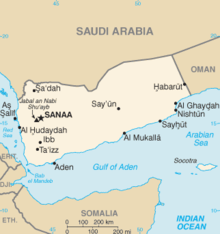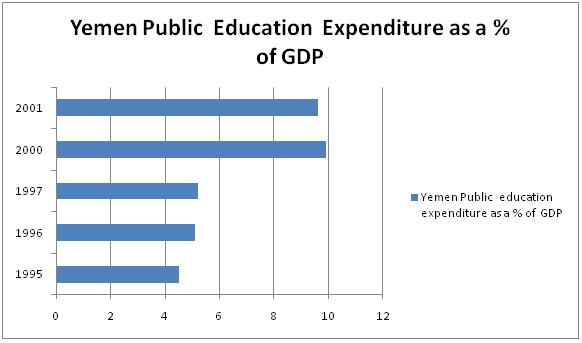
This article includes a list of references, related reading, or external links, but its sources remain unclear because it lacks inline citations. (June 2022) |
Yemen ranked 150 out of 177 in the 2006 Human Development Index and 121 out of 140 countries in the Gender Development Index (2006).[1] In 2005, 81 percent of Yemen's school-age population was enrolled in primary school; enrollment of the female population was 74 percent. Then in 2005, about 46 percent of the school-age population was enrolled in secondary school, including only 30 percent of eligible females.[2] The country is still struggling to provide the requisite infrastructure. School facilities and educational materials are of poor quality, classrooms are too few in number, and the teaching faculty is inadequate.
The Government has made the development of education system its top priority. The share of the budget dedicated to education has remained high during the past decade[which?], averaging between 14 and 20%[3] of the total government expenditure and as of 2000 it is 32.8 percent.[4] The education expenditure is 9.6 percent of GDP for the year 2001 [4] as seen in the chart below. In the strategic vision for the next 25 years since 2000, the government has committed to bring significant changes in the education system, thereby reducing illiteracy to less than 10% by 2025.[5] Although Yemen's government provides for universal, compulsory, free education for children ages six through 15, the more U.S. Department of State reports that compulsory attendance is not enforced.

- ^ "World Bank 2008."Secondary Education Development And Girls Access Project." Project Appraisal Document.pp1. The World Bank, Washington, DC" (PDF). 2008.
- ^ UNESCO Institute of Statistics database
- ^ Cite error: The named reference
www-wds.worldbank.orgwas invoked but never defined (see the help page). - ^ a b The World Bank 2008 EdStats database
- ^ Admin (2008). "Republic of Yemen, Ministry of Education Report 2008." The Development of Education in the Republic of Yemen."pp3" (PDF). International Bureau of Education. Archived from the original (PDF) on 2017-10-12. Retrieved 2009-06-05.